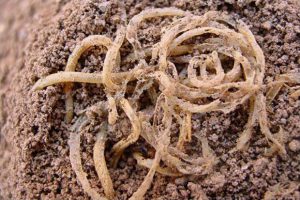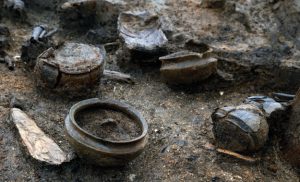Food, as a necessity for human survival, has always been the basis of any society. Archaeology that focuses on the human diet illuminates interactions between society and nature, and therefore explores their subsequent functionality. Diet is so expansive, that an array of findings can provide archaeologists with the tools for analysis. For example, earthenware found at the Lajia site in northwestern China preserved the earliest record of noodle preparation. The bowl was stuck in a floodplain of clay sediment, and radiocarbon dating suggests that these noodles were from four thousand years ago.

The millet noodles appear to be almost paper thin, with a diameter of 0.3 centimeters. They were around 50 centimeters long, with a yellow tint. They reflect many of today’s modern Chinese noodle dishes.
After analysing and attempting to determine the taxa of the noodles, archaeologists found that grass plants – specifically millet – were the basis of Chinese ingredients, and these noodles in particular. The Lajia site, found in the Loess Plateau region of China, was a semi-arid region, which is an efficient climate for millet to grow, solidifying the idea that millet was used to make noodles and other cuisine around this time period.
With the millet noodles we see how a relatively small artifact can be used to specify how the environment was utilized by the people inhabiting it. In contrast, we can also look at how a larger archaeological dig site, containing a multitude of plant matter, can shine a light on past practices. The Bronze Age Farm at Black Patch in southern England provided archaeologists with over fifty pounds of wheat, barley, and other plants. The plants were preserved through the charring of the storage pit, prompting many to dub the site as “England’s Pompeii”.

Along with pounds of edible plants, rich textiles, bronze, wooden, and ceramic artifacts were excavated at the Black Patch Farm site. The findings were uniquely preserved with a combination of waterlogging and charring.
The findings showed an increase importance of wheat, which provides insight into the progression of farming techniques, specifically the newfound reliance on winter-sown crops. Some archaeologists have also speculated that the charring of these storage pits represent the tradition of burning the deceased, and their home, after death.
It’s important to note, however, that these findings are not representative of a wide ranged understanding. In fact, both of these instances are only reflective of a specific, single period in time. The most efficient form of archaeological diet analysis is the study of food traces in the stomach, and fecal matter. Unfortunately, it’s apparent that popular science outlets tend to portray the more glamorous discoveries (like the world’s oldest noodle!) than the discoveries that provide the most accurate and relevant information on diet. Understanding bias in our sources of information – and understanding that the two examples discussed here are only a small piece in a larger puzzle – will allow us to garner a more accurate picture of our past.
Additional Reading
Swaminathan, N. (2014, August 11). Meadowcroft Rockshelter. Archaeology. Retrieved from https://www.archaeology.org/issues/150-features/americans/2369-peopling-the-americas-meadowcroft-rockshelter
Schaeffer, C. (1978). THE BISON DRIVE OF THE BLACKFEET INDIANS. Plains Anthropologist, 23(82), 243-248. Retrieved from http://www.jstor.org/stable/25667511
Image Sources
[Noodles]. (n.d.) Retrieved from http://images.mentalfloss.com/sites/default/files/styles/insert_main_wide_image/public/noodles_0.jpg
[Black Patch Farm]. (n.d.) Retrieved from https://www.archaeology.co.uk/wp-content/uploads/2016/08/mustfarmfeatured.jpg
Sources
Renfrew, Colin and Paul Bahn (2015) Archaeology Essentials. 3rd edition. Thames & Hudson, New York.
Lu, H., Yang, X., Ye, M., Liu, K., Xia, Z., Ren, X., . . . Tung-Sheng, L. (13 October 2005). Culinary archaeology: Millet noodles in Late Neolithic China. Nature, 437, 967-968. doi: 10.1038/437967a
Cunliffe, B. (2006). Iron Age Communities in Britain: An Account of England, Scotland and Wales from the Seventh Century BC until the Roman Conquest. Retrieved from https://books.google.com/books?id=v1Zkio7jluAC&pg=PA35&lpg=PA35&dq=bronze+age+farm+at+black+patch+England+wheat&source=bl&ots=iB5vgxi32M&sig=yjFdWZNAvUXX6lhY–kStS3fnwk&hl=en&sa=X&ved=0ahUKEwiB76nKlbnWAhVD04MKHUzmDUIQ6AEIZzAN#v=onepage&q=bronze%20age%20farm%20at%20black%20patch%20England%20wheat&f=false
Bruck, J. (2002). Bronze Age Landscapes: Tradition and Transformation. Retrieved from https://books.google.com/books?id=_IwgDgAAQBAJ&pg=PT315&lpg=PT315&dq=bronze+age+black+patch+farm&source=bl&ots=2uxexgp-Pw&sig=i_TBht5poZgiR5c3-cbroI1Lchk&hl=en&sa=X&ved=0ahUKEwia1d-7nrnWAhVI6YMKHTrtDIYQ6AEINzAF#v=onepage&q=black%20patch&f=false
Keys, D. (2016, July 13). Discovery of vast treasure trove of fine textiles shows importance of fashion to Bronze Age Britons. Independent. Retrieved from http://www.independent.co.uk/news/science/archaeology/vast-treasure-trove-of-fine-textiles-shows-importance-of-fashion-to-bronze-age-britons-a7135786.html
